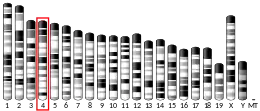Pleckstrin homology domain containing, family G member 5 (PLEKHG5) is a protein that in humans is encoded by the PLEKHG5 gene.[5] Eight transcript variants encoding different isoforms have been found for this gene.
Function
This gene encodes a protein which catalyzes the exchange of GDP for GTP within the small GTPase RhoA which in turn modulates the activation of mDia or Rock kinase to influence cell polarization. It is known to interact with the Crumbs polarity complex by binding to either of the multi PDZ domain adapter proteins Patj or Muc-1. When it is active it helps promote tight junction stabilization. siRNA inhibition of PLKHG5 has been shown to inhibit the motility of cells in scratch assays.[6][7] It has also been shown to activate the nuclear factor kappa B (NFKB1) signaling pathway.[5]
Clinical significance
Mutations in the PLEKHG5 gene are associated with distal spinal muscular atrophy type 4. This protein has also shown to be highly expressed in several glioma cell lines, and is likely a driver of tissue invasion.[8]
References
- 1 2 3 GRCh38: Ensembl release 89: ENSG00000171680 - Ensembl, May 2017
- 1 2 3 GRCm38: Ensembl release 89: ENSMUSG00000039713 - Ensembl, May 2017
- ↑ "Human PubMed Reference:". National Center for Biotechnology Information, U.S. National Library of Medicine.
- ↑ "Mouse PubMed Reference:". National Center for Biotechnology Information, U.S. National Library of Medicine.
- 1 2 "Entrez Gene: Pleckstrin homology domain containing, family G (with RhoGef domain) member 5".
- ↑ Dachsel JC, Ngok SP, Lewis-Tuffin LJ, Kourtidis A, Geyer R, Johnston L, et al. (December 2013). "The Rho guanine nucleotide exchange factor Syx regulates the balance of dia and ROCK activities to promote polarized-cancer-cell migration". Molecular and Cellular Biology. 33 (24): 4909–18. doi:10.1128/MCB.00565-13. PMC 3889543. PMID 24126053.
- ↑ Ngok SP, Lin WH, Anastasiadis PZ (August 2014). "Establishment of epithelial polarity--GEF who's minding the GAP?". Journal of Cell Science. 127 (Pt 15): 3205–15. doi:10.1242/jcs.153197. PMC 4117226. PMID 24994932.
- ↑ Liu M, Horowitz A (April 2006). "A PDZ-binding motif as a critical determinant of Rho guanine exchange factor function and cell phenotype". Molecular Biology of the Cell. 17 (4): 1880–7. doi:10.1091/mbc.e06-01-0002. PMC 1415294. PMID 16467373.
This article incorporates text from the United States National Library of Medicine, which is in the public domain.



